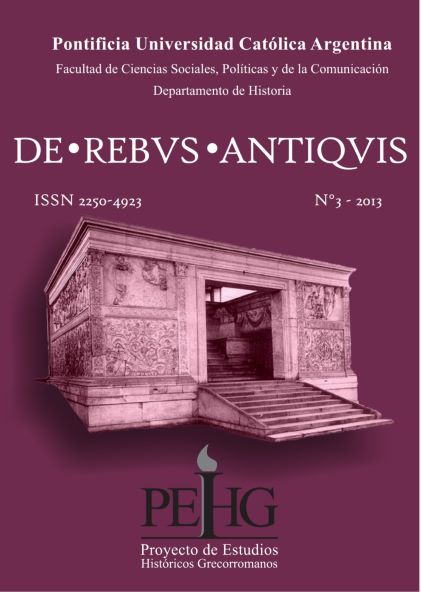A direct witness of de religious conflicts in the Fourth and Fifth Century Alexandria: Palladas of Alexandria and the Greek Antology
Keywords:
Palladas of Alexandria, Greek Anthology, epigrammatic gender, IV and V centuries A.D., tensions between Christians and PagansAbstract
Un testigo directo de las tensiones religiosas
en la Alejandría de los siglos IV y v d. C.:
Páladas de Alejandría en la Antología Palatina
Although he is the most prolific writer of the Greek Anthology, Palladas’ life is almost unknown. But, in spite of the limited biographical data, his work has fortunately been preserved in the GA. Because of his literary creation, the old times rewarded him with the nickname Μετέωρος, high, since the literary merits of a hundred poems of his authorship was recognized (others are discussed by critics). A dozen of them contains invaluable information about the political, religious and social situation in Alexandria immediately after the victory of the bishop Theophilus, Cyril’s predecessor and uncle, during the conflict between Christians and Gentiles, each sector backed up by an Alexandrian population segment (cfr. 9.528, 10.82, 10.85).
Resigned at times, constantly demanding, Palladas complains about the decline of the belief professed by him due to the increasing penetration of the new faith. Therefore, four epigrams record the conversion of the temple of Tyche into a tavern (9.180-183) and 10.90 seems to attack the doctrine of the Resurrection. When religion and politics go hand-in-hand, when religious conspiracies link up with palace intrigues, consequences are predictable: a man called Doroteo denounced him for his negative response to the new dogma, which caused him the loss of his teacher paid work. His annoyance was even greater with further sufferings, chiefly economic, and he had to sell his books (9.171 and 9.175) among other desperate decisions.
Forewarned about his radical bitterness against Church, it is just to make clear that he is not fully acquiescent with ancient gods and heroes. Thus, in 5.257 he questions Zeus’ ars amandi, in 9.377 refutes Tantalus’ possibility of thirst and hunger in Hades and 9.773 mischievously points out that Eros has been changed into a pan.
The work begins with the selection, personal translation and comprehensive analysis of twenty two epigrams. Through such philological aid, we attempt to verify the frictions and the main perceptible factors in his poetic creation to justify his worldview, according to the pagan sentiment widespread in that time before the twilight already overwhelming of its ailing traditions.
Downloads
References
AVDOKLHIN, A., “Palladas versus Christian Discourse: Late Antique Literary Epigram in the Context of Urban Inscriptions”, in: Greek Literary Epigram: From the Helenistic to the Early Byzantine Era International - Conference, London, University College London, 11-13 September 2013. Recuperado 29 de octubre, 2013, desde http://www.academia.edu/4618879/Palladas.
BALDWIN, B., ‘Palladas of Alexandria: a poet between two worlds’, Antiquité Classique 54, 1985, pp. 267-273.
BURKERT, W., Religión griega arcaica y clásica, Madrid: Abada Editores, 2007.
CAMERON, A., ‘Palladas and Christian Polemic’, The Journal of Roman Studies vol. 55, nº 1-2, 1965, pp. 17-33.
CAMERON, A. (Trad.), The Greek Anthology from Meleager to Planudes, Oxford: Clarendon Press, 1993.
COUGNI, E. (Ed.), Epigrammatum Anthologia Palatina; cum Planudeis et appendice nova epigrammatum veterum ex libris et marmoribus ductorum. Graece et latine, vol. 3, Paris: Ambrosio Firmin-Didot et Sociis, 1927.
DI BERARDINO, A. (Dir.), Diccionario patrístico y de la antigüedad cristiana (2 vols.), Salamanca: Ediciones Sígueme, 2ª ed., 1998.
DÜBNER, F., Epigrammatum Anthologia Palatina, cum Planudeis et appendice nova, Volumen primum, Paris: Ambrosio Firmin-Didot et Sociis, 1927.
HERRERO-INGELMO, M.C., (Trad.), Pausanias. Descripción de Grecia Libros III-VI (vol. 2), Barcelona: Gredos, 2002.
GUIDORIZZI, G., “Capitolo Undicesimo: l’epigramma”, en: Lana, I. - Maltese, E.V. (Dirs.), Storia della civiltà letteraria greca e latina, Vol. 2: “Dall’ Ellenismo all’ età di Traiano”, Torino: Unione Tipografico-Editrice Torinese, 1998, pp. 181-224.
LIDDELL, H.G. & SCOTT, R. (Eds.), Greek-English Lexicon, Oxford: University Press, 9ª ed., 1996.
PATON, W. R. (Ed.), The Greek Anthology (Vols. 1, 3, 4), Harvard: Harvard University Press (edición bilingüe), 1956-58.
RONCHEY, S., Ipazia: la vera istoria, Milano: Rizzoli, 2010.
WALTZ, P. - Guillon, J. et alii (Eds.), Anthologie Grecque, Paris: Les Belles Lettres, 1928-1980.
WILKINSON, K. W., ‘Palladas and the Age of Constantine’, The Journal of Roman Studies 99, 2009, pp. 36–60. WILKINSON, K.W., ‘Some Neologisms in the Epigrams of Palladas’, Greek, Roman, and Byzantine Studies 50, 2010, pp. 295–308.
Published
How to Cite
Issue
Section
License










